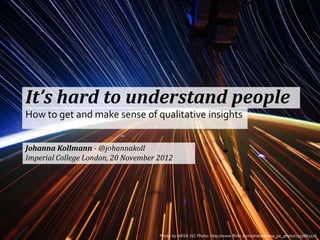
ICStartup 3: customer development
- 1. It’s hard to understand people How to get and make sense of qualitative insights Johanna Kollmann - @johannakoll Imperial College London, 20 November 2012 Photo by NASA JSC Photo: http://www.flickr.com/photos/nasa_jsc_photo/7257865176
- 2. (Some) research methods (yeah we have a lot) Quantitative Qualitative Surveys Contextual inquiry Generative Interviews Mental models Interviews Diary studies Automated card sort Usability testing Surveys Moderated card sort Evaluative Automated studies Wizard of Oz Analytics A/B Testing Multi-variant testing Adapted from figures by Janice Fraser, Nate Bolt, Christian Rohrer
- 3. Before you leave the building
- 4. Plan who to talk to where about what and why Photo by angelamaphone http://www.flickr.com/photos/angelamaphone/2663422833//
- 7. What topics shall the interview cover? Dieting Buying food Exercise Preparing food Eating out Busy lifestyle Struggles
- 8. Prompts rather than set questions Day-in-a-life (today, yesterday) Decide what to eat Last time on a diet How active (want vs. do) Preparing food for oneself Preparing food for family/friends
- 9. Have a ‘softball question’ ready Please tell me a little bit about your cooking this week. Could you tell me about the last dish you prepared yourself?
- 10. Photo by TheeErin: http://www.flickr.com/photos/theeerin/4729019845/
- 11. Out in the wild
- 12. Ask open questions – don’t lead YAY NAY • Who • Did • What • Have • When • Are • Where • Were • Why • Will • How Were you trying to do A or B? What were you trying to do?
- 13. Some great all-purpose questions • Has there ever been a time when you had x experience? • Could you tell me about that? • What was great about that? • What was awful about that? • Why did you do that? • And then, what happened? • If you had a magic wand, what would you make the situation be like? By Janice Fraser
- 14. Do’s and don’ts Photo by Hilde Skjølberg http://www.flickr.com/photos/hebe/3004800079/
- 15. Do Be the learner, not the expert Ask naïve questions Ask for specific stories Allow people time to think Listen! Take notes or record Take photos or collect artefacts Photo by Tomas Hellberg http://www.flickr.com/photos/tomhe/35312882/
- 16. Don’t Be an interrogator Ask questions that sound like blame, or argumentative Ask for solutions Try to solve problems during the interview Ask what features people want Ask people to imagine theoretical situations Photo by G Meyer http://www.flickr.com/photos/kainet/144703613/
- 17. Making sense of what you saw and heard
- 19. Photos taken at DesignJam London events by Rachel Winch and falkowata
- 23. Human activity systems Soft Systems Methodology Peter Checkland
- 24. Leverage points… …places within a complex system where a small shift in one thing can produce big changes in everything. …are often counterintuitive.
- 25. Rich Picture 1. Construction of the Humber Bridge (adapted from Stewart and Fortune, 1994) © The Open University 2. Distance Learning Situation © Wood-Harper et al, Information Systems Definition: The Multiview Approach, Blackwell Scientific Publications 1985
- 26. Rich Picture elements Stakeholders Worldview Connections Conflicts 2. Distance Learning Situation © Wood-Harper et al, Information Systems Definition: The Multiview Approach, Blackwell Scientific Publications 1985
- 29. Resources Notes from my Leancamp session on this topic http://johannakoll.posterous.com/ux-research-tips- for-customer-development-not Mental Models by Indi Young Storytelling for User Experience by Whitney Quesenbery & Kevin Brooks Remote Research by Nate Bolt & Tony Tulathimutte Undercover User Experience by Cennydd Bowles Designing for the Digital Age by Kim Goodwin LUXr resources and materials by Janice Fraser (http://www.slideshare.net/clevergirl/) and Lane Halley (http://www.slideshare.net/LaneHalley/) Articles on User Interface Engineering (http://www.uie.com/browse/usability_testing/)
- 30. The intuitive mind is a sacred gift and the rational mind is a faithful servant. We have created a society that honors the servant and has forgotten the gift. We will not solve the problems of the world from the same level of thinking we were at when we created them. More than anything else, this new century demands new thinking: We must change our materially based analyses of the world around us to include broader, more multidimensional perspectives. ~Albert Einstein
Hinweis der Redaktion
- Non-leading interviews allow you to capture what a person is thinking in their terms, with their structure and vocabulary intact. Indi deliberately writes prompts rather than interview questions. Also easier to parse quickly. if you go for a non-directed interview using prompts, make sure everybody in your team has a shared understanding of the intent behind each topic. Janice calls this topic map.
- Non-leading interviews allow you to capture what a person is thinking in their terms, with their structure and vocabulary intact. Indi deliberately writes prompts rather than interview questions. Also easier to parse quickly. if you go for a non-directed interview using prompts, make sure everybody in your team has a shared understanding of the intent behind each topic. Janice calls this topic map.
- begin interviews with a 'softball' question - a question that is simple to answer and puts the participant at ease.
- Be careful with WHY. ‘How did you know that X?’ ‘What were you thinking at the moment when X?’ This does not interrupt the recounting process. So ‘tell me how it was that you came to be looking for this site that day’ does the work of ‘why were you looking... ?If you’ve made people comfortable, Why should be ok.
- Manage expectations
- what we saw/heard – what it means – why it matters
- BM channels = connections
- Map out connections – Rich Picture
- examples: eg hard system = thermostat, motherboard. soft system = game of poker, soccer game, meeting, healthcare.
- Worldview is a concept for empathyConsider:- roles that people adopt in the situation (which may be formally recognised or quite informal); the norms which govern people’s behaviour; and the values they espouse.- political aspects of the situation, in other words recognition of the different interests that are represented and how these different interests are accommodated.